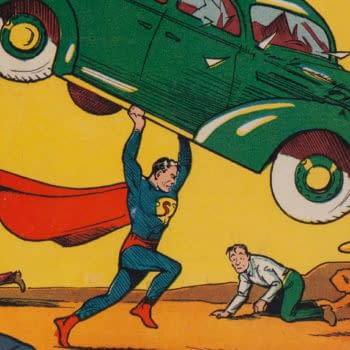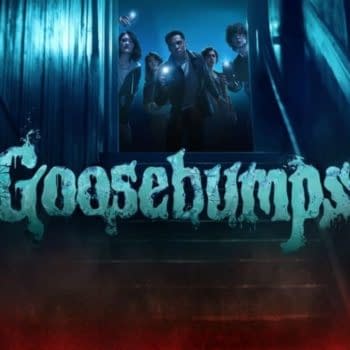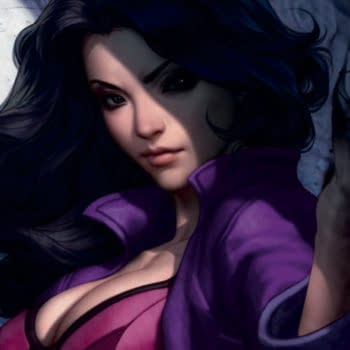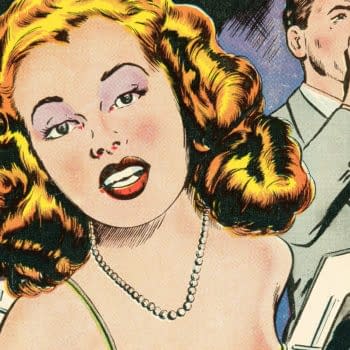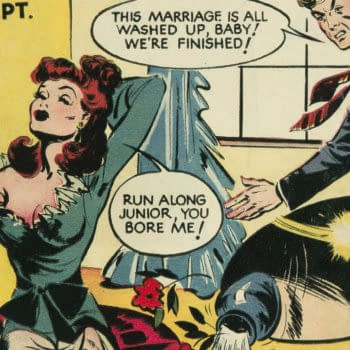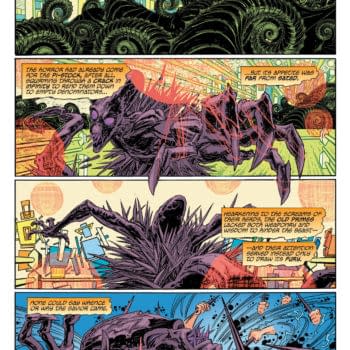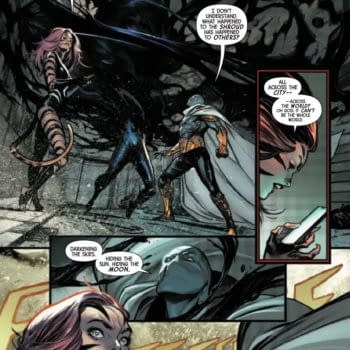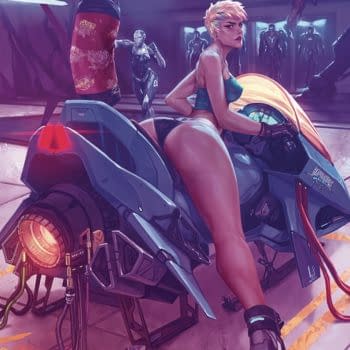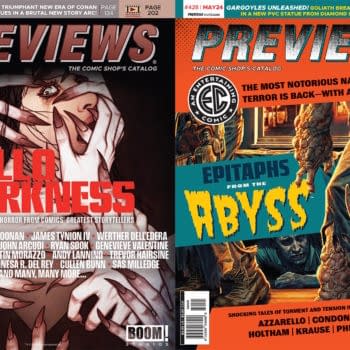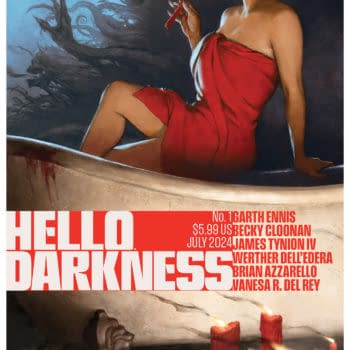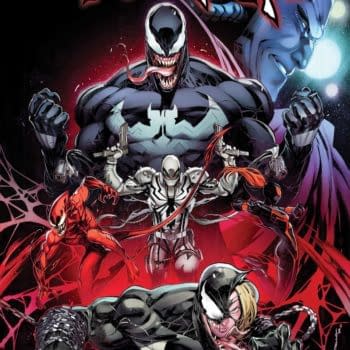Posted in: Comics, Heritage Sponsored, Vintage Paper | Tagged: golden age, human torch, marvel, namor
Namor vs Human Torch in Marvel Mystery Comics #9, Up for Auction
Considered one of the most important Marvel comics ever published, Marvel Mystery Comics #9 helped set the stage for the Marvel Universe.
The importance of Marvel Mystery Comics #9 has been apparent to serious fans and collectors for decades. In 1969, the debut issue of the Marvelmania fanzine called out this pivotal moment in Marvel comics history by noting, "Timely Comics, forerunner of the present Marvel group… were the first to combine super-heroes from two different strips. This first classic meeting took place in the eighth and ninth issues of Marvel Mystery Comics (June and July, 1940) between the blazing Human Torch and the mighty Prince Namor, the Sub-Mariner. This story proved so popular that Timely pitted these two drawing cards against each other in many succeeding battles, including one epic 60-page battle in an issue of the Human Torch. Perhaps this struggle between fire and water held a special magnetism, but more companies began attempting the teaming of their top characters."
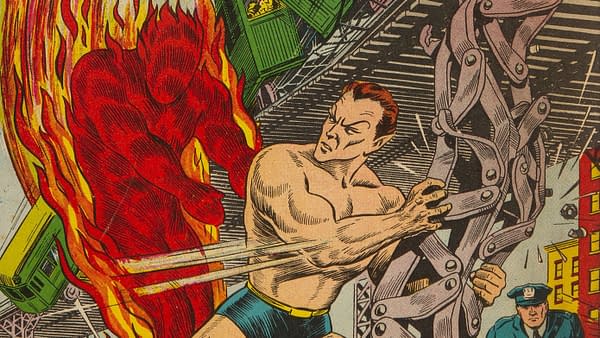
While the notion that it was the first comic book superhero crossover is not quite correct (Top-Notch Comics #5, which began a fascinating Shield/Wizard crossover saga, beat Marvel Mystery Comics #8 to the newsstand by about a month), the importance of Marvel Mystery Comics #9 in the context of what it would presage at the publisher, remains undeniable to the present day. Over 50 years after that 1969 Marvelmania commentary, Marvel Mystery Comics #9 was the second comic book listed (after Marvel Comics #1, the very first comic book from the publisher) in the 2020 book Marvel Greatest Comics: 100 Comics that Built a Universe, with a quote from Marvel Senior Vice President of Publishing Tom Brevoort stating, "It set the template for the eventual Marvel Universe, a world in which all of the assorted heroes and villains live together in the same shared space."
For serious vintage Marvel comic book collectors, it just doesn't get much better than this. This issue has forever been in demand, and copies rarely come up for public sale. As one of the most important Golden Age Marvel/Timely issues featuring Namor, demand for this issue seems destined to increase as Namor joins the Marvel Cinematic Universe. The foundational Marvel character will be played by Tenoch Huerta, beginning in Black Panther: Wakanda Forever. With high-grade unrestored copies virtually impossible on the public market, this very nicely presenting Marvel Mystery Comics #9 (Timely, 1940) CGC Apparent FN 6.0 Slight to Moderate (A-2) Cream to off-white pages up for auction in the 2022 September 8 – 11 Comics & Comic Art Signature® Auction #7279 at Heritage Auctions is arguably one of the best copies to be available at public auction in the past decade.
Practically every detail of this saga has made its way into countless books on comics history. Even the creation of the storyline became the stuff of legend. On the title page of Marvel Mystery Comics #9 itself, the story is credited to Sub-Mariner creator Bill Everett, Human Torch creator Carl Burgos, and Funnies, Inc. writer and editor John H. Compton. But in Jim Steranko's two-volume The Steranko History of Comics, for which both Everett and Burgos were interviewed, the development of this story is elaborated upon in great detail. According to this telling, once Everett and Burgos decided on the basic concept, Funnies, Inc. head Lloyd Jacquet relayed the idea to Marvel publisher Martin Goodman, who wanted it done immediately. "Carl and Bill sat down at the drawing boards and composed the first two pages without having the slightest notion about storyline. John Compton came in and began to plot out a script. Then Jack D'Arcy from Hillman Publications showed up, found a corner and began to work. Mike Roy and Harry Sahle followed and started doing breakdowns and backgrounds. George Kapitan and Hank Chapman dropped in next to lend their writing talents. Then Joseph Piazza, being unable to find a place to work, set up his writing quarters in the bathtub. Breakdowns were penciled as soon as page-by-page synopses were completed. Finished dialogue was written directly on the pages, then lettered. They all teamed up to produce the story a page at a time, making it up as they went along. Reams of paper littered the floor. Bottles collected in corners. Everybody was yelling their own ideas at the rest. Artists and writers slept in shifts. More than a dozen showed up over the weekend. The radio and record player were going full blast. Neighbors complained and called the cops. The telephone never stopped ringing. It was the comic industry's version of Duck Soup."
There's a lot to unpack from that anecdote. In the interest of clarity, some spelling corrections to the names of the mentioned contributors have been made from the original text of this quote, and there are aspects of this anecdote that are open to interpretation. In his book Marvel: Five Fabulous Decades of the World's Greatest Comics, author Les Daniels outlines an abbreviated version of this anecdote, and is in apparent agreement with Steranko that it is about the creation of the storyline for Marvel Mystery Comics #8 and/or #9. However, GCD seems to connect it to a later Namor/Torch battle in Human Torch #5, perhaps under the theory that the full-issue-length 60-page saga was more likely to cause an all-hands call than the 45-page original crossover, which is spread out over Marvel Mystery Comics #8-10 (22 pages for #8, 22 pages for #9, and a single page in #10). The book Marvel Greatest Comics: 100 Comics that Built a Universe credits Marvel Mystery Comics #9 to Everett, Burgos, Compton, and Ray Gill, based on additional information from Steve Ditko's 160 Page Package #3. Gill was the older brother of frequent Silver Age Ditko collaborator Joe Gill. It's my opinion that the anecdote as related by Steranko most likely refers to Marvel Mystery Comics #8/9, with some details embellished or misremembered over the course of time. Regardless, the notion that Namor/Torch crossovers developed a legend even among creators of the day is telling.
While Everett and Burgos are deservedly legendary names in comics history, John H. Compton is a lesser-known figure involved in this key moment who is deserving of more attention. Available evidence suggests that Compton was particularly associated with the work of Burgos, and may have been a regular scripter or collaborator for the Human Torch creator. There exists a Funnies, Inc. file copy of the very first Marvel comic, Marvel Comics #1 with Compton's name stamped on it, and with his hand-written color corrections for the debut Human Torch story in that issue, theorized to be unused color corrections meant for the second printing. Steranko associates Compton with Burgos and the Human Torch at a couple of additional points in his history, and Compton is credited as the co-creator with Burgos of the superhero character the Thunderer in Daring Mystery Comics #7 (April 1941).
According to U.S. Census records, Compton was born in 1908 in Pennsylvania. The 1930 Census lists him as a magazine writer living in Manhattan with his mother and sister, who are both listed as motion picture actresses. His mother, Christine Compton, is credited by IMDB in the silent era film comedy The Perfect Sap (1927). His sister Betty Compton, born in 1915, was an actress not to be confused with the slightly older British actress of the same name from this era. By the 1940 census, John H. Compton's occupation is listed as "Editorial", and he's living in Queens with a wife and family. Compton was a pulp writer throughout the 1930s and beyond, contributing stories to titles such as The Phantom Detective, Doc Savage, Double Action Western, Ace-High Magazine, and The Shadow Magazine. Writer's Digest lists Compton as the editor of Hillman's Air Fighters Comics at the launch of that title in late 1941.
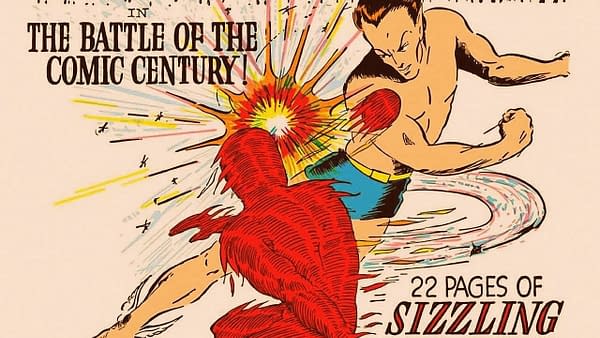
The story that Everett, Burgos, Compton, and perhaps others crafted for Marvel Mystery Comics #9 was cleverly built up from the groundwork laid by the prior eight issues of the series. The seeds of the particular conflict that set Namor and the Torch on a collision course were planted in Marvel Mystery Comics #2. The Sub-Mariner travels to New York City in that issue and immediately creates havoc, eventually killing several policemen. While seemingly a throw-away moment of comic book violence in that issue, these murders would not be forgotten. In issue #3, the NYC police enlist officer Betty Dean in a plan to capture Namor. After this plan fails, Betty still persuades the Sub-Mariner to fight on the side of America in the brewing World War. But when Namor returns to NYC with the intent to do just that in Marvel Mystery Comics #5, he is instead captured by the police, who use drugs to subdue him, and who seemingly have not forgotten the fatal results of his previous visit. Despite efforts to redeem himself in issue #6, Namor is put on trial for murder and found guilty. Authorities use drugs to sap his strength and they attempt to execute him via electrocution, but the electric chair instead revives his strength, and he escapes.
Marvel Mystery Comics #7 then sets up the conflict of the subsequent issues three issues. In the Human Torch story, the Torch joins the police force. Then, in the Sub-Mariner story of this same issue, Namor again returns to NYC with the intent of getting his revenge on America and conquering it, starting with New York City. In a hint of things to come, Betty Dean warns him that the Human Torch is a member of the police force now, and will likely oppose him. In issue #8, Namor and the Human Torch occasionally spar as the Sub-Mariner creates havoc throughout New York City.
But Marvel Mystery Comics #9 is clearly the main event. These natural enemies engage in a fierce struggle throughout the 22-page story. The final battle takes place at Torpey Chemical Works, named after Funnies, Inc. sales manager Frank Torpey. After the Torch fails in his attempt to defeat Namor with a sulphuric acid attack, Namor traps the Torch in an air-tight cylinder. As the one-page conclusion in Marvel Mystery Comics #10 explains, this left the pair at a stalemate. The Human Torch was trapped, but if the Sub-Mariner attempted to kill the Torch or leave, the Torch would instantly escape. As noted in the explanatory blurb on that final page, "In other words, it really was a complete deadlock." With Betty Dean's intervention, Namor agrees to leave in peace if the Torch promises not to pursue him.
The historically important issue #9 has an iconic cover worthy of its significance, which CGC credits to Bill Everett and Alex Schomburg. GCD credits the cover solely to Schomburg. This initial saga must have been every bit the hit it is purported to have been, as Marvel followed up with Torch/Namor crossovers in Human Torch #3 (Winter 1940/41, text story only), Marvel Mystery Comics #17 (March 1941), Human Torch #5 (Fall 1941), Human Torch #8 (Summer 1942), and Human Torch #10 (Winter 1942/43). The Torch/Namor battle from Marvel Mystery Comics #9 was first reprinted for Silver Age readers in Fantasy Masterpieces #8 (April 1967) and has been reprinted a number of times since then.
In the context of its time, Marvel Mystery #9 is worth every bit of the attention that it has received in the 82 years since its release. Widely considered one of the most important Marvel comic books ever published, collectors will rarely have a chance at a better-presenting copy than this Marvel Mystery Comics #9 (Timely, 1940) CGC Apparent FN 6.0 Slight to Moderate (A-2) Cream to off-white pages up for auction in the 2022 September 8 – 11 Comics & Comic Art Signature® Auction #7279 at Heritage Auctions.
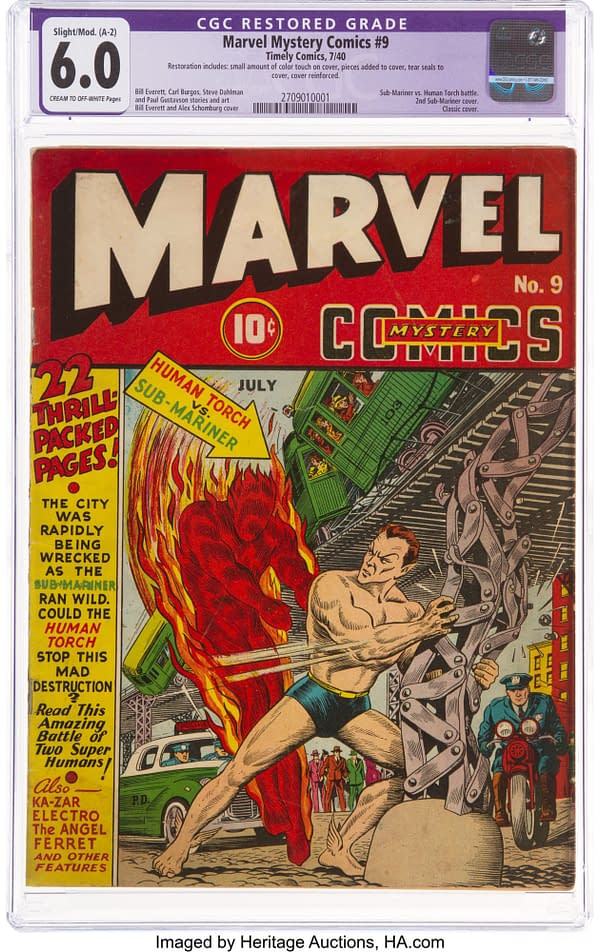
Marvel Mystery Comics #9 (Timely, 1940) CGC Apparent FN 6.0 Slight to Moderate (A-2) Cream to off-white pages. Overstreet and Gerber both lists this book as "scarce". The Human Torch and Sub-Mariner battle on this classic Alex Schomburg cover, which was the second one to feature the Sub-Mariner. Art by Bill Everett, Carl Burgos, Paul Gustavson, Al Anders, and Irwin Hasen. Currently #35 on Overstreet's list of Top 100 Golden Age Comics. CGC notes, "Restoration includes: small amount of color touch on cover, pieces added to cover, tear seals to cover, cover reinforced." Overstreet 2022 GD 2.0 value = $5,100; VG 4.0 value = $10,200; FN 6.0 value = $15,300.
CGC Grader Notes:
scuff left center of back cover
wear spine
interior spine reinforced
light staining to cover
moderate creasing to cover
pieces added cover A-2
small amount of color touch on cover
tear seals top back cover Conserved





